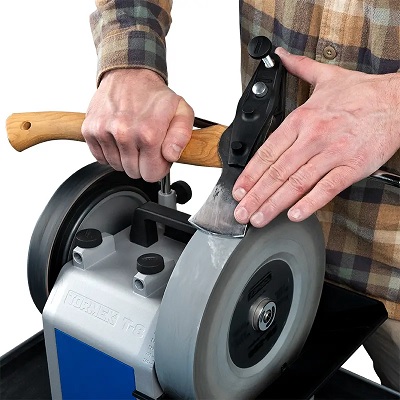✔ Competitive Pricing ✔ Quality Service ✔ Extensive Stock ✔ Experienced Staff
 Price
PriceTormek Axe Jig Explained (AX-40)
Axe Jig (AX-40)
You'll be amazed at how sharp you can make virtually any axe with the AX-40 Axe Jig. The composite jaws close securely around the axe head, allowing for a simple, symmetrical, and precise sharpening. The axe jig lets you sharpen concave, flat or convex bevels, whatever may suit your axe and its area of use the best. It fits all kinds of axes, from hatchets to carpenters’ axes, carving axes and broad axes – virtually any axe you’ll find will get a perfect sharpening.

Why Choose the AX-40 Axe Jig?
Convex, Flat or Concave Bevels
The AX-40 Axe Jig lets you sharpen any kind of axe to a convex, flat, or concave bevel. Each jaw of the jig has two stops that lets you make a controlled movement between the stops to sharpen a convex bevel. You can also sharpen a slightly hollow grind by just using one of the stops as your point of reference. To get a completely flat bevel you sharpen on the side if a diamond grinding wheel using the MB-102 Multi Base.
Straight or Curved Edges
Outdoor axes and carving axes usually have a curved edge, while splitting mauls and carpenter's axes usually have an almost straight edge. Since the stops on the axe jig are rounded, it is easy to follow the shape of the edge whether it is straight or curved. You’ll have nice and consistent bevels on all your axes!
Sharpening Angle by Use
With the AX-40 Axe Jig, you have complete freedom to choose the best sharpening angle for your axe using the WM-200 AngleMaster. The edge angle for an all-round axe for sports and outdoor use is bigger than for a carving axe, to be able to withstand more force. A splitting maul requires an even bigger edge angle. Carving axes can be sharpened asymmetrically, with a smaller angle and larger bevel on the left-hand side (if you're right-handed). That will make the axe cut and carve more easily because the cutting force is closer to the direction of cutting.
Extreme Versatility
Not only is the AX-40 Axe Jig versatile in the variety of types of axes it can sharpen, but it also offers a broad range in positioning when sharpening. You can either sharpen edge trailing (the edge in the same direction as the rotation of the grinding wheel) or edge leading (the edge against the direction of rotation), standing or sitting on either side of the machine. This makes it possible find what position best suits you and your axes.
Find the Axe Jig (AX-40) here
See the full range of Tormek Sharpening Systems, Jigs and Grinding Wheels





 01726 828 388
01726 828 388






